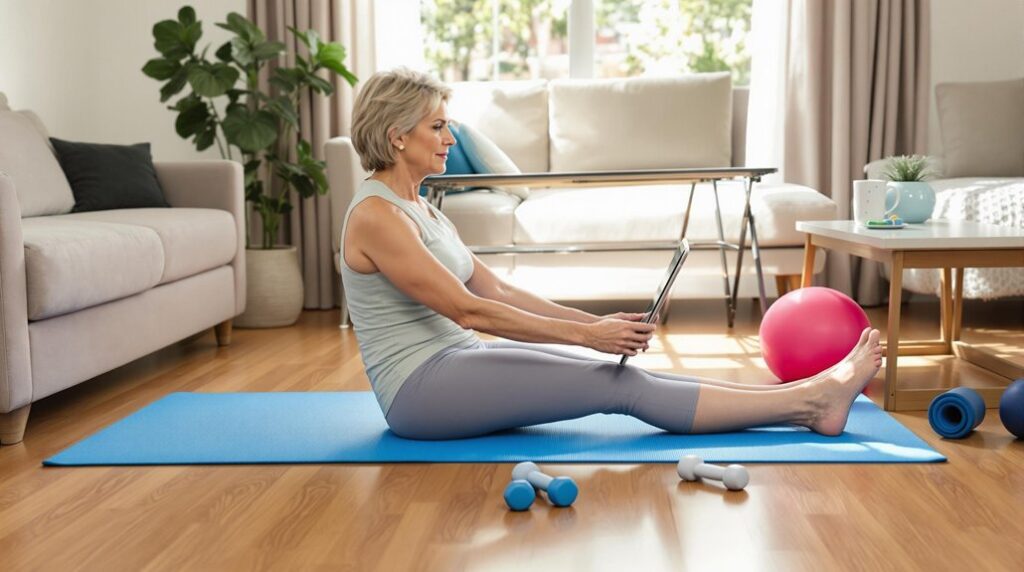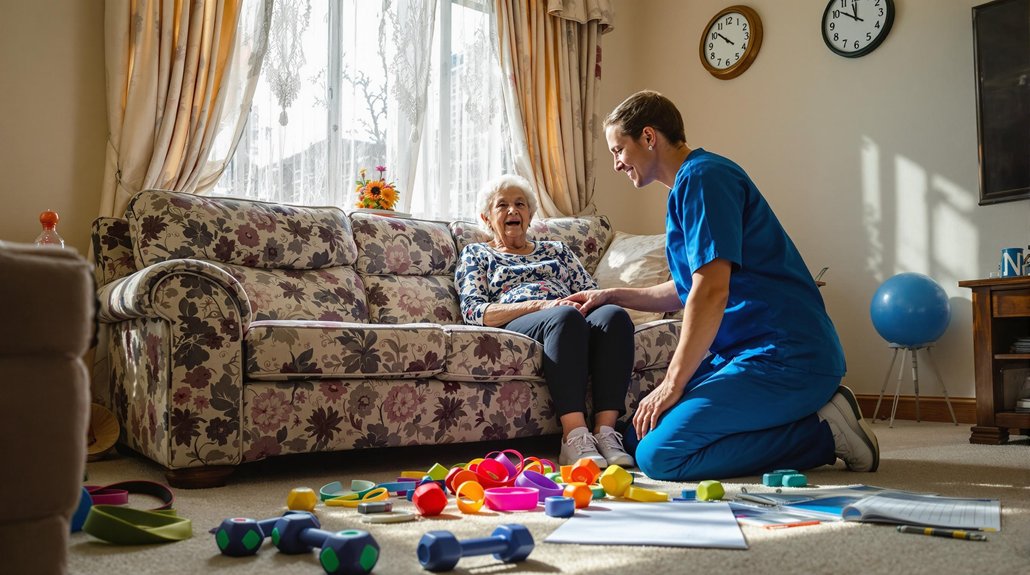Yes, you can effectively do physical therapy at home with proper guidance and setup. You’ll need basic equipment like resistance bands, foam rollers, and light weights, plus a dedicated space that’s well-lit and obstacle-free. To guarantee success, you should track your progress, follow safety guidelines, and maintain regular communication with your physical therapist. The key is creating a structured, safe environment where you can focus on your recovery goals and healing journey.
Benefits of Home-Based Physical Therapy
While traditional clinic-based physical therapy remains common, receiving treatment in your home environment offers distinct advantages.
You’ll benefit from home convenience, eliminating travel time, transportation costs, and the stress of maneuvering through traffic or weather conditions. Your therapist can assess your living space and customize exercises based on your home setup and daily routines.
Personalized sessions in your residence allow for more focused, one-on-one attention without the distractions of a busy clinic.
Your therapist can identify potential hazards or mobility challenges specific to your home environment and recommend practical modifications. You’ll also learn to use everyday household items as therapy tools, making it easier to maintain your exercise routine between sessions.
This familiarity helps you build confidence in performing activities of daily living within your actual living space.
Home health PT can include specialized services like post-surgical rehabilitation, stroke recovery, and chronic pain management.
Essential Equipment for At-Home Rehabilitation
Although sophisticated gym equipment can enhance rehabilitation, you don’t need complex machines for effective at-home physical therapy. Basic equipment like resistance bands, foam rollers, and light dumbbells can help you perform most prescribed exercises effectively.
Start with resistance bands in various tensions, which provide adaptable strength training and help improve flexibility. A sturdy chair, yoga mat, and balance balls are essential for stability exercises and core strengthening.
You’ll also benefit from having small hand weights, ankle weights, and a full-length mirror to check your form. Keep ice packs and heating pads readily available for pain management.
Remember to choose equipment that matches your therapist’s recommendations and your specific rehabilitation needs. Many of these items are affordable and don’t require much storage space. Licensed therapists can develop customized treatment plans that incorporate these basic tools to help you regain mobility and strength at home.
Setting Up Your Home Exercise Space
With your equipment selected, creating a dedicated exercise space at home sets you up for successful rehabilitation. Choose a well-ventilated area with enough room to move freely and perform prescribed exercises safely.
A dedicated home exercise space, properly equipped and sized, is essential for effective rehabilitation and therapeutic success.
Guarantee adequate lighting and a non-slip surface to prevent accidents during therapy sessions.
Consider necessary home modifications to accommodate your rehabilitation needs. Clear the space of furniture and obstacles that could interfere with movement.
If you’re using equipment like resistance bands or stability balls, install secure anchor points or storage solutions to keep items organized and readily accessible.
Position a mirror on the wall to monitor your form during exercises, and keep a water bottle and small towel nearby.
Your exercise space should feel inviting and motivating, encouraging you to maintain your therapy routine.
A comprehensive home safety assessment from an occupational therapist can help identify optimal space setup and necessary modifications for your therapy needs.
Safety Guidelines and Best Practices
Before starting any home-based physical therapy routine, you must prioritize safety to prevent injuries and guarantee the best recovery. Assess your home safety by removing obstacles, ensuring proper lighting, and having sturdy furniture for support. You’ll need to understand exercise modifications that match your current ability level.
| Safety Element | What to Check | Action Required |
|---|---|---|
| Floor Surface | Slip Hazards | Remove loose rugs |
| Lighting | Visibility | Install bright bulbs |
| Equipment | Condition | Inspect before use |
| Space | Clearance | Clear 6-foot radius |
| Support | Stability | Test furniture stability |
Always keep your phone nearby for emergencies, and don’t hesitate to modify exercises if they cause pain. Start slowly and progress gradually, paying attention to proper form and breathing techniques. Remember, it’s better to perform fewer repetitions correctly than risk injury with improper execution. Post-operative care services can provide professional guidance for safe and effective home-based physical therapy exercises.
Tracking Progress and Measuring Success
Since tracking your physical therapy progress is essential for staying motivated and ensuring effectiveness, you’ll need to establish clear measurement methods from day one.
Keep a detailed log of your exercises, including repetitions, resistance levels, and any pain or discomfort you experience.
Document your progress indicators through photos, range-of-motion measurements, and strength assessments. You can use smartphone apps or simple tools like a measuring tape or stopwatch to record these metrics.
Set realistic success milestones with specific targets, such as “walk for 10 minutes without assistance” or “lift arm above shoulder height.”
Share your tracking data with your physical therapist regularly, allowing them to adjust your program as needed.
Remember to celebrate small victories and use setbacks as learning opportunities to refine your approach.
Licensed professionals can provide specialized therapy services to help you maintain proper form and technique while recovering in your home environment.
When to Seek Professional In-Person Care
Although home-based physical therapy can be effective for many conditions, you’ll need to recognize when professional in-person care becomes necessary.
Watch for red flags like severe pain that doesn’t improve, numbness, or sudden weakness in your limbs. These symptoms require immediate medical attention and proper injury assessment from a licensed professional.
Seek in-person care if you experience chronic pain lasting more than three months, notice declining mobility, or develop new physical limitations that interfere with daily activities.
Additionally, if you’re unable to perform exercises correctly or aren’t seeing improvement after several weeks of home therapy, it’s time to consult a physical therapist.
They can modify your treatment plan, guarantee proper technique, and provide hands-on manual therapy that’s impossible to replicate at home.
Conclusion
Home-based physical therapy works well when you put in the effort and have the right tools. Just like Sarah, who healed from her knee surgery by doing exercises at home and meeting with her therapist online, you too can reach your health goals. Think of it like building a house – you need a good plan, the right tools, and someone to guide you along the way.
Remember, you’re not alone on this journey. While many exercises can be done safely at home, it’s important to listen to your body. If something hurts more than it should or you’re not seeing the progress you hoped for, that’s your body’s way of saying it needs extra help.
At Focus Family Care, we’re here to support you every step of the way, like a trusted friend who knows exactly how to help. Your health and comfort are our top priorities.
If you or a loved one need help, don’t wait. Reach out to Focus Family Care today at (561) 693-1311 or email us at info@focusfamilycare.com.





